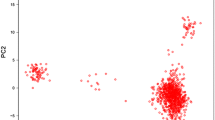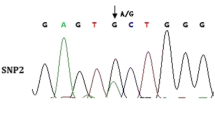Abstract
Silent information regulator (SIRT1), was closely associated with senescence, metabolism, and apoptosis. The objective of this study was to investigate whether SIRT1 gene could be used as a candidate gene in the breeding process of Qinchuan cattle. Via sequencing technology conducted in 453 individuals of Qinchuan cattle, single nucleotide polymorphisms (G25764A, A25846G, and T25868C) with 5 haplotypes and 6 combined genotypes in 3′ untranslated region of SIRT1 gene were identified. In addition, three loci were significantly associated with some of the body measurements and meat quality traits in Qinchuan cattle (P < 0.05), and the H2H2 (GG–AA–CC) diplotypes had better performance than other combinations in Qinchuan cattle. These results suggest that the SIRT1 gene could be used in marker assisted selection to improve the production traits of Qinchuan cattle.





Similar content being viewed by others
References
Poirier P, Giles TD, Bray GA, Hong Y, Stern JS et al (2006) Obesity and cardiovascular disease: pathophysiology, evaluation, and effect of weight loss. Arterioscler Thromb Vasc Biol 26:968–976
Lee YS (2009) The role of genes in the current obesity epidemic. Ann Acad Med Singapore 38:45–47
Walley AJ, Asher JE, Froguel P (2009) The genetic contribution to non-syndromic human obesity. Nat Rev Genet 10:431–442
Smith JS, Brachmann CB, Celic I, Kenna MA et al (2000) A phylogenetically conserved NAD+-dependent protein deacetylase activity in the Sir2 protein family. Proc Natl Acad Sci USA 97:6658–6663
Imai SI, Armstrong CM, Kaeberlein M, Guarente L (2000) Transcriptional silencing and longevity protein Sir2 is an NAD dependent histone deacetylase. Nature 403:795–800
Liang F, Kume S, Koya D (2009) SIRT1 and insulin resistance. Nat Rev Endocrinol 5:367–373
Wojcik M, MacMarcjanek K, Wozniak L (2009) A physiological and pathophysiological functions of SIRT1. Mini Rev Med Chem 9(3):386–394
North BJ, Verdin E (2004) SIRTuins: sir2-related NAD-dependent protein deacetylases. Genome Biol 5:224
Motta MC, Divecha N, Lemieux M et al (2004) Mammalian SIRT1 represses forkhead transcription factors. Cell 116(4):551–563
Fulco M, Schiltz RL, Iezzi S et al (2003) Sir2 regulates skeletal muscle differentiation as a potential sensor of the redox state. Mol Cell 12:51–62
Luo J, Nikolaev AY, Imai S et al (2001) Negative control of p53 by Sir2a promotes cell survival under stress. Cell 107:137–148
Rodgers JT, Lerin C, Haas W et al (2005) Nutrient control of glucose homeostasis through a complex of PGC-1alpha and SIRT1. Nature 434(7029):113–118
Picard F, Kurtev M, Chung N et al (2004) SIRT1 promotes fat mobilization in white adipocytes by repressing PPAR-γ. Nature 429:771–776
Qiao L, Shao J (2006) SIRT1 regulates adiponectin gene expression through Foxo1-C/Enhancer-binding protein γ transcriptional complex. J Biol Chem 281:39915–39924
Bai L, Pang WJ, Yang YJ, Yang GS (2007) Modulation of SIRT1 by resveratrol and nicotinamide alters proliferation and differentiation of pig preadipocytes. Mol Cell Biochem 307:129–140
Backesjo CM, Li Y, Lindgren U, Haldosen LA (2009) Activation of SIRT1 decreases adipocyte formation during osteoblast differentiation of mesenchymal stem cells. Cells Tissues Organs 189:93–97
Cohen K, Artsi H, Levin A, Abramowitz E et al (2011) SIRT1 Is a regulator of bone mass and a repressor of sost encoding for sclerostin, a bone formation inhibitor. Endocrinology 152(12):4514–4524
Gilbert RP, Bailey DR, and Shannon (1993) NH linear body measurements of cattle before and after 20 years of selection for post weaning gain when fed two different diets. J Anim Sci 71: 1712–1720
Nei M, Roychoudhury AK (1974) Sampling variance of heterozygosity and genetic distance. Genetics 76:379–390
Barrett JC, Fry B, Maller J, Daly MJ (2005) Haploview: analysis and visualization of LD and haplotype maps. Bioinformatics 21(2):263–265
Julie L, Kirstin E, Nick AS (2009) Real-Time PCR: Current Technology and Applications. Caister Academic Press, Norfolk
Ardlie KG, Kruglyak L, Seielstad M (2002) Patterns of linkage disequilibrium in the human genome. Nat Rev Genet 3:299–309
Li MX, Sun XM, Hua LS et al (2013) SIRT1 gene polymorphisms are associated with growth traits in Nanyang cattle. Mol Cell Probes 27:215–220
Li MX, Sun XM, Zhang LZ et al (2013) A novel c.-274C > G polymorphism in bovine SIRT1 gene contributes to diminished promoter activity and is associated with increased body size. Anim Genet 44:584–587
Liu YF, Zan LS, Zhao SP, Xin YP et al (2010) Molecular characterization, polymorphism of bovine ZBTB38 gene and association with body measurement traits in native Chinese cattle breeds. Mol Biol Rep 37:4041–4049
Dekkers JC (2004) Commercial application of marker- and gene-assisted selection in livestock: strategies and lessons. J Anim Sci 13:313–328
Camargo GM, Cardoso DF, Gil FM, Fonseca PD et al (2012) First polymorphisms in JY-1 gene in cattle (Bos taurus indicus) and their association with sexual precocity and growth traits. Mol Biol Rep 39(12):10105–10109
Alim MA, Fan YP, Wu XP, Xie Y et al (2012) Genetic effects of stearoyl-coenzyme A desaturase (SCD) polymorphism on milk production traits in the Chinese dairy population. Mol Biol Rep 39(9):8733–8740
Cinar MU, Kayan A, Uddin MJ, Jonas E et al (2012) Association and expression quantitative trait loci (e QTL) analysis of porcine AMBP, GC and PPP1R3B genes with meat quality traits. Mol Biol Rep 39(4):4809–4821
Sun C, Zhang F, Ge X et al (2007) SIRTl improves insulin sensitivity under insulin-resistant conditions by repressing PTPIB. Cell Metab 6:307–319
Kuningas M, Putters M, Westendorp RG, Slagboom PE et al (2007) SIRT1 Gene, Age-Related Diseases and Mortality. J Gerontol A 62:960–965
Figarska SM, Vonk JM, Boezen HM (2013) SIRT1 polymorphism, long-term survival and glucose. PLoS One 8(3):1–6
Suwa M, Nakano H, Radak Z et al (2008) Endurance exercise increases the SIRT1 and peroxisome proliferator-activated receptor γ coactivator -1α protein expressions in rat skeletal muscle. Metabolism 57(7):986–998
Balestrieri ML, Rienzo M, Felice F et al (2008) High glucose downregulates endothelial progenitor cell number via SIRT1. Biochim Biophys Acta 1784(6):936–945
Bordone L, Motta MC, Picard F et al (2006) SIRT1 regulates insulin secretion by repressing UCP2 in pancreatic β cells. PLoS Biol 4(2):210–220
Hozumi YG, Gallardo AG, Dávalos LG et al (2007) Bovine sirtuins: initial characterization and expression of Sirt1 and Sirt3 in liver, muscle, and adipose tissue. J Anim Sci 89(8):2529–2536
Acknowledgments
We are grateful to Professor Zan Linsen for providing the necessary materials used to accomplish this research work. The research was supported by the National “Five year” Science and Technology Support Project (#2011BAD28B04-03), the China National 863 Program (#2011AA100307), the GMO New Varieties Major Project (#2011ZX08007-002), the National Beef and Yak Industrial Technology System (#CARS-38), Chinese Beef Cattle Economically Important Traits Functional Genomics Studies Project (2013AA102505), Identification And Regulation of Qinchuan Cattle Meat Quality Traits Functional Gene Project (31272411).
Author information
Authors and Affiliations
Corresponding author
Rights and permissions
About this article
Cite this article
Gui, L., Wang, H., Wei, S. et al. Molecular characterization, expression profiles, and analysis of Qinchuan cattle SIRT1 gene association with meat quality and body measurement traits (Bos taurus). Mol Biol Rep 41, 5237–5246 (2014). https://doi.org/10.1007/s11033-014-3393-1
Received:
Accepted:
Published:
Issue Date:
DOI: https://doi.org/10.1007/s11033-014-3393-1




